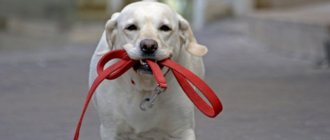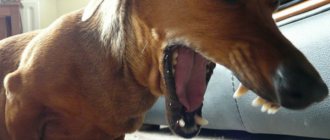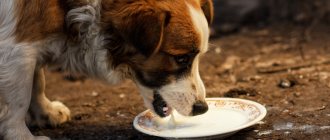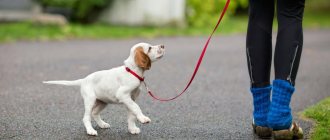Caring for a dog after sterilization on the first day
The first day after sterilization is especially important for the animal. When recovering from anesthesia, the dog may behave inappropriately, may pee under itself, or fall out of a chair or bed. For this reason, it should not be placed in elevated places. The bed must be covered with a sterile disposable diaper (sold in pharmacies) and changed regularly when it gets wet.
Sterilization operation
Important! If urinary incontinence occurs for a long time after the release of anesthesia, consultation with a veterinarian is necessary.
The place for the operated dog should not be in a passage, in a draft, or near heating devices. It is advisable to cover the bitch with something warm on top so that she does not get pneumonia, since at this time the body temperature drops and life processes slow down.
Anesthesia after surgery usually wears off within 2-3 hours, but it will take at least a day for the dog to finally come to its senses. At this time, you should not leave the dog for a long time. Anesthesia can cause panic in an animal, a feeling of anxiety, and unreasonable aggression. This is not something to be afraid of. Everything will return to normal as soon as the anesthesia completely leaves the body. At this time, you need to stay close to your pet, create a quiet, calm environment for him, and warn your family not to disturb him.
Note! The answer to the question of how long it takes a dog to recover from anesthesia after sterilization depends on the drug administered, its dosage, and the characteristics of the animal’s body.
Dog castration price
In any clinic, the cost of castration of dogs varies, based primarily on the size of the animal and gender. In addition, prices vary between private and public veterinary hospitals.
As a rule, in any case, castration of females will cost more. The cost of the procedure also includes the price of medications, anesthetics and materials used:
- up to 5 kg – 2000-2500 rub.
- from 5 to 15 kg – 2500-3000 rub.
- from 15 to 25 kg – 3000-3500 rub.
- from 25 to 35 kg – 3500-4000 rub.
- from 35 to 45 kg – 4000-5000 rub.
- from 46 kg and more – 5000-7000 rubles.
It is possible to call a specialist to your home, in which case the cost of the operation increases within 1000 rubles. Castration will also be more expensive at night and in the presence of associated complications.
The need for blankets
Cat after sterilization: care at home
After the sterilization operation and treatment of the sutures, in order to prevent infection from entering the wound, the dog is put on a special blanket, and, if necessary, a collar. A postoperative blanket is also necessary to prevent the dog from licking the seam. It also supports the abdominal cavity, preventing the formation of hernias and suture divergence.
The blanket should always be clean. When going outside with your pet, it should be protected with a jumpsuit, and if it gets dirty, change it for a clean one. During a winter walk, the blanket is insulated on top to prevent the seams from getting cold. This accessory is worn, if there are no complications, for 2-3 weeks. During this time, the pet should not be subjected to physical stress.
Postoperative blanket
The dog may not like wearing foreign things; it will try to take it off, refuse to eat, and in every possible way show inconvenience in movement. You should not follow the dog’s lead, as this is fraught with bad consequences. While your pet is recovering, wearing a blanket is essential.
Positive aspects of castration
Among the advantages of castration of dogs are the following:
- a dog of any gender becomes more suitable for keeping in an apartment;
- males calm down, stop showing aggression towards others and in 50% of cases mark everything around them;
- the male not only refuses to start fights, but also becomes uninteresting to other belligerent males;
- sexual desire decreases over time, and interest in the opposite sex disappears;
- dogs lose their tendency to run away and wander;
- castration prevents cancer of the genital organs in old age;
- in bitches it most often occurs, therefore it is recommended to castrate the ovaries along with the uterus;
- the operation will protect the animal from sexually transmitted infections.
The animal stops worrying, its appetite increases and sleep improves, and a great desire to play and be mischievous appears. If he had attempts to gain leadership in the house, then they gradually fade away.
Of course, castration cannot completely affect the character of the pet, but only partially corrects it. For more obvious changes you need sufficient physical activity and training. In some cases, the animal becomes balanced only with age.
There is a myth that castration reduces the protective qualities of dogs, but in reality there is no connection. If the dog was an excellent watchdog, then after the operation it will remain so.
Seam processing
At home, the sutures of the operated animal are regularly treated with a disinfectant, then with an ointment or aerosol 2 times a day until they are completely healed. The crusts formed after the operation are moistened with hydrogen peroxide until they soften, then removed.
After sterilization, the cat asks the cat: is this normal and what to do?
If the wound is poorly treated or licked, an inflammatory process may begin. When an infection gets into the wound, the animal vomits, the temperature rises, increased thirst appears, and the heartbeat quickens. Such symptoms require immediate medical examination and a course of antibiotics.
Note! If your dog whines after sterilization or is in pain, you can give painkillers after consulting with your doctor.
Postoperative sutures
For joint pain
Any painkiller will help relieve joint pain. But pharmacists produce special medications for the musculoskeletal system. In addition to analgesic substances, the products contain components that stimulate the restoration of joints and ligaments.
Quadrisol
The best remedy for relieving symptoms of arthrosis, dysplasia, arthritis. Quadrisol is packaged in dispenser syringes - one of 15 ml costs 300-400 rubles.
Quadrisol is given forcibly or mixed with wet food. Dosage – 1 ml per 10 kg every day. The course of treatment is 2-4 weeks, after a 7-day break the therapy is repeated as prescribed by the veterinarian.
Norocarp
A nonsteroidal anti-inflammatory drug prescribed for acute and chronic inflammation of joints, ligaments, fractures, and intervertebral hernias.
Norocarp is produced in tablets. The daily norm is 4 mg per 1 kg, divided into 2 doses. The medicine is given for a week; if the dog’s condition improves, the dose is reduced by half. The duration of the course of treatment is determined by the veterinarian.
Norocarp costs 230-500 rubles. depending on the release form - 20, 50 or 100 mg.
Hondartron-gel
Homeopathic medicine for external use. Contains a squeeze of medicinal herbs, bee venom, calcium fluoride and lithium carbonate. Hondatron:
- relieves inflammation, swelling;
- reduces pain symptoms;
- normalizes lymphatic drainage, blood flow and trophism (nutrition) of joints;
- stimulates the restoration of cartilage and joint tissues.
Chondartron is used in combination with other drugs to restore joints. The gel is applied evenly to the affected areas, avoiding damage.
They sell Hondatron-gel for 360 rubles. for a 75 ml bottle, and 1,200 rubles. per 500 ml tube.
Features of skin and coat care
Due to the removal of the uterus and gonads, a hormonal imbalance occurs in the body, which in turn leads to disruption of the natural change of hair and undercoat. Shedding of hair in bitches usually occurs after the cessation of estrus.
Chihuahua: care and maintenance at home
In the absence of estrus as a result of surgical intervention, the body stops sending signals about a change in coat, the fur begins to grow randomly and profusely, which leads to a change in the appearance of the pet. In this case, the dog needs additional care for its coat.
Note! Skin and coat care depends on the dog's breed and coat type.
Short-haired dogs, such as Dobermans, dachshunds, Dalmatians, pugs, and hounds, are not subject to any special changes in their coat. In long-haired breeds with undercoat, such as Akita Inu, Husky, Spitz, Corgi, Shepherd, a side effect of sterilization can be an abundant growth of undercoat, which requires frequent combing or plucking.
In dogs such as the Poodle, Yorkshire Terrier, Bichon Frize, and Maltese, the outer coat and undercoat differ little from each other; they do not undergo significant changes during sterilization.
Most often, the coat of dogs with a mixture of long and short hair undergoes changes. These include spaniels, retrievers, setters, greyhounds, Pekingese, Japanese chin and others. Their fur becomes softer, so it mats quickly and difficult to comb tangles form. As a result, the dog's appearance suffers. In this case, the wool requires additional care.
Grooming
The hard, wiry coat of Shih Tzus, Giant Schnauzers, Afghan Hounds, and some types of terriers also suffers. As a result of sterilization of the animal, it loses its natural rigidity, becomes softer, and requires cutting with scissors instead of the usual trimming, which can only increase the growth of fluffy and soft fur.
Nutrition during the recovery period
You can feed your dog no earlier than 10 hours after sterilization. Before feeding, fluids must be provided. After surgery, dogs often experience constipation, which is accompanied by pain. This must be regulated with nutrition until digestion is restored.
Food should be given in a pureed, semi-liquid state in small portions, but often. The food should be well balanced and include dairy products. If the dog refuses to eat and only drinks water, there is no need to force it to eat. You should start to worry if your pet refuses to eat food for more than three days.
Post-operative care
In order for your pet to finally “come to his senses” as quickly as possible, he should be cared for and observed after surgery. Much depends on postoperative care. In the first hours, feeding should not be painful. You should not force feed your dog. When the dog becomes more active and shows interest in food, you should give it some meat and porridge, and give it clean water. Then feed as usual.
It is better to keep sterilized animals in a warm place and avoid cold. In order to prevent the risk of complications after castration, in the form of infections, antibiotics are prescribed. Within a few days, a male dog may experience swelling, swelling, swelling in the injured area, and also swelling of the scrotum. Don't worry, if you care for your dog after castration correctly, these phenomena will go away after three days.
Full recovery will occur in about a month, remember that good care of the male dog after castration will make rehabilitation even faster. During this period, the dog’s owner must monitor the applied bandage and care for the injured area. The bandage should not tighten the animal's body, and he should not gnaw or remove it. The dressings are changed according to the degree of contamination. The seams are treated with an antiseptic. After recovery, the dog can be bathed and all contaminated areas are washed. You just need to make sure that the wound is gone.
You should immediately contact a veterinarian if the stitches begin to bleed or rot, your dog has a fever or is vomiting. It should be noted that complications after this procedure are extremely rare. Over time, you will understand that the dog’s behavior has changed, this happens over the course of a year, you will notice that the dog has stopped marking, has become more reserved, calmer, and is in a good disposition towards people and children.
What to do if your dog won't let you approach him
After anesthesia, a dog may behave inappropriately and may begin to hallucinate. She may not recognize the owner, not allow anyone to approach her, or behave aggressively. In such cases, doctors advise not to panic, you just need to wait for time, calmly observing her, and help her calm down. This behavior will go away as the anesthesia leaves the body.
Sad pet
Possible complications in a dog after castration
After castration, the animal may lack appetite. The reason for this may be the blanket. In such cases, it is removed for feeding and then put on again.
When processing seams, you should pay attention to the color of your pet's skin. Its pale appearance may indicate internal bleeding, which may occur due to poor blood clotting or inept actions of the operating veterinarian.
Another complication after surgery can be ruptured internal sutures. Lumps under the skin are formed as a result of the prolapse of internal organs beyond the walls of the abdominal cavity. Also, after anesthesia, problems with the knee joints are possible.
When is a veterinarian needed?
In general, animals tolerate sterilization without complications. But there are times when the help of a veterinarian is necessary. Such cases include:
- lack of urination for more than a day;
- absence of stool for more than 2 days or the presence of blood in the stool;
- pale or bluish skin;
- cardiopalmus;
- convulsions, fainting;
- difficulty breathing with an open mouth, wheezing;
- increase or decrease in temperature.
The reason for contacting a veterinarian is also suppuration of the wound, bleeding from it, vomiting, prolonged apathy, and lethargy.
Many postoperative complications can be avoided by strictly following the rules of care, a detailed list of which can be obtained from a veterinary clinic. If any deviations in the animal’s behavior are observed, it is necessary to immediately show it to a doctor and undergo a course of treatment.
Cases of visiting a doctor after sterilization or castration?
Bleeding from a wound
If ichor is released - a pinkish-yellow liquid that remains on the blanket - this is normal. If the color of the blood becomes bright scarlet and flows out profusely, in this case, immediately contact a veterinary clinic.
Lack of appetite
In the first 2 days after sterilization or castration, a lack of appetite is normal. However, by day 3 this illness should go away. In particular, too little activity of the animal or paleness of the mucous membrane is a good reason to consult a veterinarian.
Increased body temperature
Normal cat body temperature: 38.0-39.5 (there are exceptions for breeds); dogs: 37.5-39.0.
After 3-4 days, if your pet or pet, in addition to apathy, has a temperature above normal, you should immediately consult a doctor. Because there is a possibility of infection during the operation. In this case, the animal will need to undergo antibacterial therapy.
Let us note that in the majority of cases, when an operation is performed by a highly qualified veterinarian in a clinic, such situations do not arise. Therefore, always choose your doctor and clinic carefully.
You can learn more about sterilization and castration of animals in Belarus and Russia on our website or consult with our veterinarians.
Any owner sooner or later begins to worry about the topic of sterilization. There is a lot of conflicting information around about the timing and methods of the operation. We will help you understand the nuances of dog sterilization and answer your questions.










